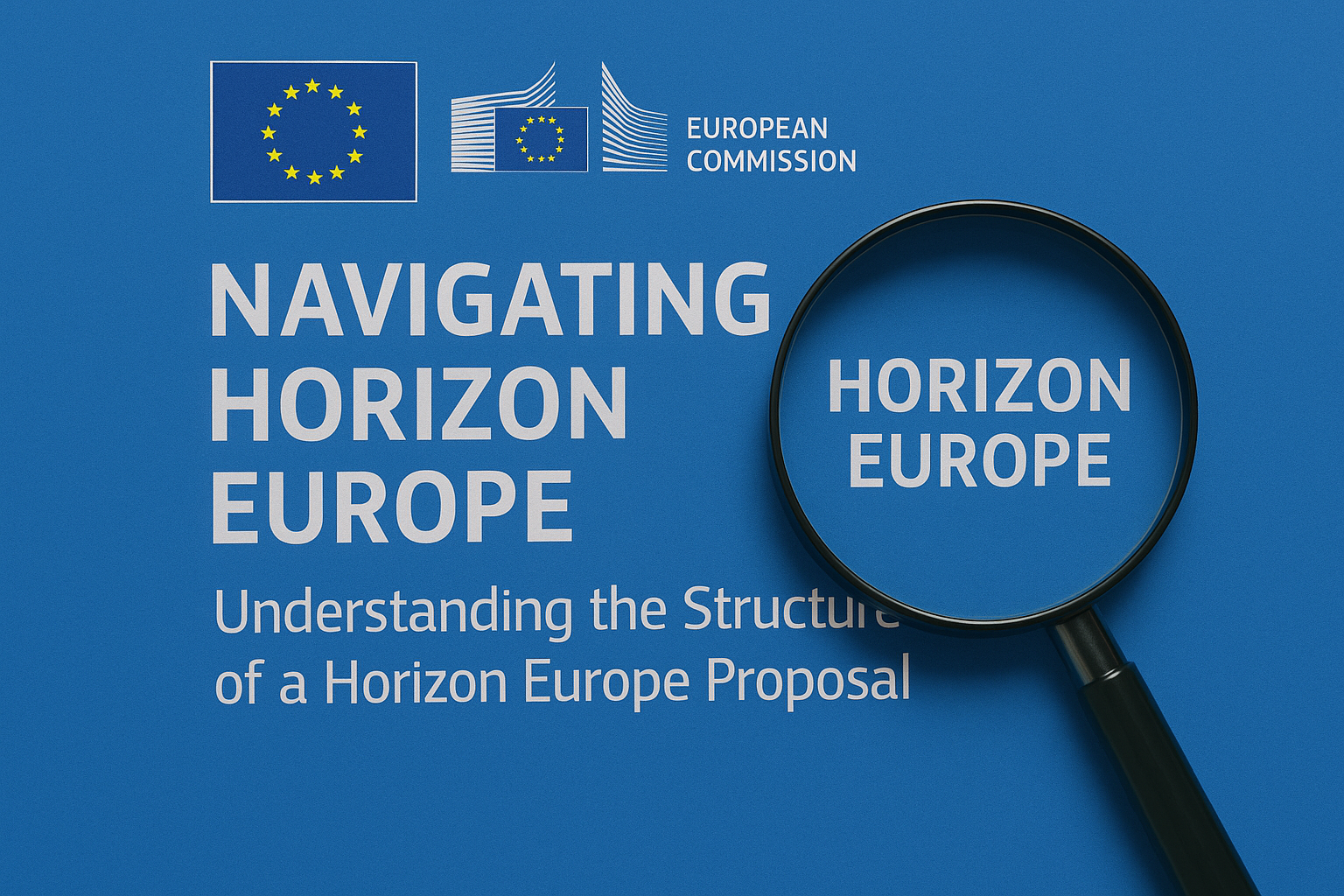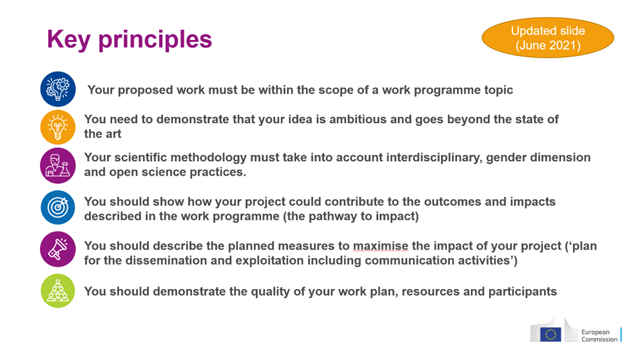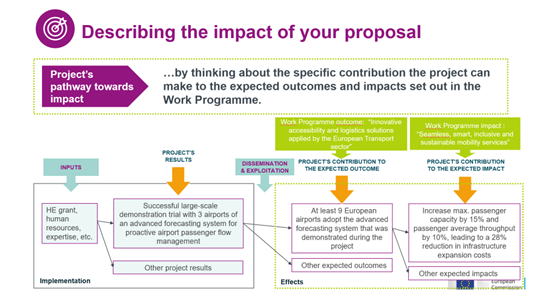Creating a successful Horizon Europe (HE) proposal involves a meticulous process that ensures that all necessary components are thoroughly addressed. This blog post will guide you through the structure of a Horizon Europe proposal, detailing each section and what should be included to maximize your chances of success. As someone who has written tens of HE proposals, I’d like to share my experience on how to understand the different parts of HE proposal and what they ideally should include.
 Picture: Copilot
Picture: Copilot
A Horizon Europe proposal is typically divided into three main sections: Excellence, Impact, and Implementation. Each section plays a crucial role in demonstrating the value and feasibility of your project. Before going into more detail about each section, this picture below from the European Commission’s HE guidelines explains the key aspects that you should always keep in mind when preparing a HE proposal.
 Picture: How to prepare a successful proposal in Horizon Europe (European Commission 2021)
Picture: How to prepare a successful proposal in Horizon Europe (European Commission 2021)
Excellence
The Excellence section is where you outline the core idea of your project. You should include a list of the project’s objectives that should be Specific, Measurable, Achievable, Relevant, and Time-bound (SMART). For example, if your project aims to develop a new technology, you should describe what the technology is, what it aims to achieve, and how it goes beyond the current state-of-the-art (Karvonen, Mattila & Talvinen 2024). In addition, you should explain what the ambition is behind your idea. What is the novelty behind your idea that is so relevant and important that it should be funded.
Explain clearly what is the exact GAP and NEED that you addressing and filling with your project idea?
You also need to explain the current State of the Art in this specific field, and how you intend to go beyond it with this project. State of the art refers to the highest level of development. In a HE proposal, this means providing a comprehensive overview of the current knowledge and existing technologies related to your project, including Current Research and Developments, Existing Solutions and Comparing different approaches to highlight the most advanced and relevant ones. The goal is to demonstrate that you have a thorough understanding of the current landscape and can identify gaps or limitations that your project aims to address.
Beyond state of the art refers to the innovative aspects of your project that go beyond the current highest level of development. This is where you highlight how your project will advance the field and provide new solutions. You should explain how your project introduces new concepts, methodologies, or technologies that surpass existing solutions, detailing the specific advancements your project aims to achieve and how they will push the boundaries of current knowledge. And finally, highlight the benefits and improvements over existing solutions.
By clearly articulating both the state of the art and how your project goes beyond it, you can effectively demonstrate the novelty and significance of your proposal. This is crucial for convincing evaluators of the value and potential impact of your project within the Horizon Europe framework.
The final part of the Excellence is the Methodology section, where you should provide a detailed explanation of the methods and approaches you will use to achieve your objectives. This includes the concepts, models, and assumptions that underpin your work. You should also describe how you will integrate expertise from different disciplines and how you will manage research data and other outputs.
Impact
Impact is about demonstrating the value of your project in addressing the challenges outlined in the Horizon Europe work programme. à A strong impact section will show that your project is not only scientifically sound but also socially and economically valuable. The Impact section includes two parts: Project’s Path towards Impact: where you should explain how your project’s results will make a difference beyond its immediate scope and duration. For instance, if your project aims to reduce carbon emissions, explain how it will achieve this and the broader environmental benefits.
The second part is called Measures to Maximize Impact and is your project’s plan for communicating, disseminating and exploiting the project’s results. Here the focus lies on describing your strategy for all the project’s communication activities, intellectual property management, and how you will engage with stakeholders. For example, you might plan to publish your findings in open-access journals, present at conferences, or collaborate with industry partners to commercialize your innovations.
Remember that Impact is connected to a time, a place and an actor and it always has a magnitude. In other words, you should be able to specify when a certain impact will arise and after which specific actions. This can prove to be difficult but try to think about it like this: First an impact shows in the primary target group, i.e., for practitioners in a certain EU country; then it is scaled to fit other EU countries and from there to the general market. The magnitude of the Impact means that the relevance of the actions differs in relation to the set goals. If the goal is to reduce Nano plastics in the Baltic Sea, a single technical solution can have a big magnitude, but if the goal is to increase the biodiversity of the Baltic Sea, the same solution’s magnitude could be much smaller (Karvonen, Mattila & Talvinen, 2024).
 Picture: How to prepare a successful proposal in Horizon Europe (European Commission 2021)
Picture: How to prepare a successful proposal in Horizon Europe (European Commission 2021)
Implementation
The Implementation section details how you practically will carry out your project. This part should provide a clear and detailed plan of the project’s activities. It has to include a Gantt chart or similar graphical representation of the project timeline, a list of work packages, and descriptions of each work package. Each work package should have specific tasks, deliverables, and milestones.
Finally, you should describe the project consortium and the roles of each partner. Why is this group of partners the perfect consortium to carry out the earlier described project work. In other words: How are you complementing each and making a winning team? It is also important here to highlight the expertise and resources that each partner brings to the project. For instance, if one partner is a leading research institution in a relevant field, emphasize their experience and capabilities.
Be concise and clear with your work description and link the work package titles directly to the expected outcomes from the call text. It should be crystal clear for the evaluators which work package answers to which expected outcome.
Conclusion
Writing a Horizon Europe proposal is a collaborative effort that requires careful planning and coordination. Each section of the proposal serves a specific purpose and must be crafted to meet the expectations of the evaluators. By clearly articulating the excellence, impact, and implementation of your project, you can create a compelling proposal that stands out.
References